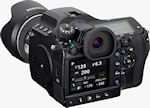 Pentax 645D: Weather-sealed 40mpix medium format
Pentax 645D: Weather-sealed 40mpix medium format
By
Mike Tomkins
(Wednesday, March 10, 2010 - 19:16 EST)
Hoya Corp. has today unveiled the Pentax 645D, a long-awaited medium format SLR whose development was first announced way back in March 2005.
At the time, Pentax was predicting the 645D to be based around an 18.6 megapixel CCD image sensor from Kodak, while later plans called for a 31.6 megapixel Kodak sensor instead. After a brief relegation to the back burner after Pentax's merger with Hoya Corp., the 645D has been resurrected - and the specifications have again been updated. As confirmed by Kodak themselves, they remain the sensor supplier for the final launch version of the 645D, but with yet another upgrade to a design based around a Kodak KAF-40000 CCD sensor offering 40 megapixel resolution. As compared to a 3:2 aspect ratio 35mm full-frame sensor, the 4:3 aspect Kodak KAF-40000 offers 1.68 times more surface area. There's also no optical low-pass filter, ensuring the maximum image detail (but relying on software techniques and lens design to help prevent moire). The flagship Pentax 645D includes many features previously seen in the company's APS-C prosumer K-7 model. These include a fully sealed body that resists dust, weather and cold to -10° celsius, PENTAX Real Image Engine II (PRIME II) image processor, Dust Removal II (DR II) mechanism using piezoelectric vibration of the UV/IR cut filter, 3.0" LCD display with 100% field of view and 921,000 dot resolution (using a glass cover plate like the Pentax K-7 Limited Silver), power from a D-LI90 lithium-ion rechargeable battery pack, and a selection of USB, HDMI Type-C and NTSC / PAL composite video connectors. Other features previously seen in the K-7 include copyright tagging, a digital level function (but without correction, since the sensor isn't mounted on a movable platter), in-camera HDR, dynamic range expansion and distortion / aberration correction, as well as the Color Temperature Enhancement white balance mode that helps emphasis color of sunsets, etc. Images are metered with a 77-segment sensor offering three modes - multi-segment, center-weighted or spot. There's also an 11-point phase detection AF system with continuous and single operation, and the ability to select points automatically or manually, but the AF sensor chip is a new model dubbed SAFOX IX+, catering to the wider area of the 645D's sensor. Like the K-7, images are stored on SD or SDHC cards (but not the latest SDXC types), but the Pentax 645D does include two SD card slots to allow either automatic overflow, simultaneous backup or segregation of images by file type. Eight creative modes like those in the K-7 allow tuning of parameters like contrast, saturation, hue, sharpness, and more, and include a new reversal film option. The 645D's on-screen interface also looks to bear more than a passing resemblance to that of the K-7, although with some rearrangement to cater to pro use and the camera's differing feature set. Many points where the Pentax 645D varies significantly from its sibling - beyond the medium format lens mount and sensor, and the pro-friendly body with features such as a mirror lock-up knob - is in its variabless relating to exposure. Burst shooting is possible at 1.1 frames per second for 15 JPEG or 13 Raw frames. Shutter speed ranges from 1/4000 to 30 seconds plus bulb (with noise reduction after 30 seconds), forgoing the K-7's maximum 1/8000 shutter (and shutter life is rated at 50,000 cycles, half that of the K-7). Sensitivity ranges from ISO 200 to 1,000 equivalents ordinarily, and can be expanded to a range of ISO 100 to 1,600. As you'd expect given the target market (and the much greater sensor size and weight), there's also no in-body image stabilization. There's also no live view or movie functionality, due to the choice of a CCD image sensor rather than a CMOS chip, with images being framed on a trapezoid prism viewfinder offering 98% field of view. Only one notable function really appears may be absent for the Pentax 645D's target market: the specs make no mention of tethering capability. This has to date been the case with the prosumer K-7 model as well, and it's something we'd hope to see the company rectify in the future. Tethering can add significant convenience in studio shooting, as an alternative to sneakernet transportation of flash cards between camera and computer. The Pentax 645D is initially available only in Japan from mid-May 2010, where pricing has been set at ¥807,620 excluding sales tax (roughly equivalent to US$8,900, ignoring exchange rate fluctuations, taxes and duties.) Plans in other markets haven't been publicly announced. Asked about the possibility of a US release, Ned Bunnell, President of US division Pentax Imaging Co. stated: "The 645D will initially be available only in Japan. Right now, we have no firm plans to bring this camera to the US. However, we are evaluating the type of sales and support program that would be required to ensure the 645D's success in our market." Following below are detailed specifications provided by Hoya Corp. | Pentax 645D | 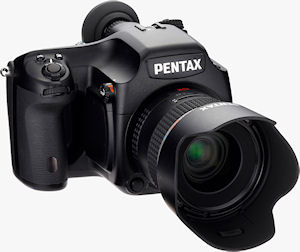 | | General | | Camera Type | Pro SLR | | Manufacturer | Pentax | | Model Number | North America: 645D
| | Dimensions | 6.1 x 4.6 x 4.7 in.
(156 x 117 x 119 mm) | | Weight | 52.2 oz (1,480 g) | | Image Capture | | Sensor Type | Kodak KAF-40000 CCD
44mm x 33mm (approx. 2.17 in. diagonal)
40.01 megapixels (total)
40.00 megapixels (effective) | | Filter Type | RGBG | | Aspect Ratio | 4:3 | | Image Dimensions | 7264 x 5440 (39.5 megapixels)
6528 x 4896 (32.0 megapixels)
5376 x 4032 (21.7 megapixels)
4224 x 3168 (13.4 megapixels)
3072 x 2304 (7.1 megapixels)
| | Capture Speed | Continuous: 1.1 frames per second for 15 frames | | Image Preview / Review | | Viewfinder | Yes, Trapezoid prism finder w/ Natural-Bright-Matte focusing screen.
98% field of view | | LCD | 3.0 in. diagonal
921,000 dots (approx. 307,000 pixels)
100% field of view | | Lens | | Lens Type | Interchangeable Lens | | Lens Mount | PENTAX 645AF2 bayonet mount | | Image Stabilization | No | | Focusing System | 11-point SAFOX IX+ Phase Difference Detection, single / continuous
Does not have AF assist lamp
Manual focus possible | | Exposure | | ISO Sensitivity | 100*, 125*, 140*, 160*, 200, 250, 280, 320, 400, 500, 560, 640, 800, 1000, 1100*, 1250*, 1600* (*expanded values) | | Shutter Speed | 30 - 1/4000 second | | Exposure Modes | Aperture, Shutter, Manual | | Metering Modes | 77-segment multi, center-weighted, spot | | Exposure Compensation | +/- 5.0EV in 1/3EV increments | | White Balance | Image Sensor - Auto, Daylight, Shade, Cloudy, Fluorescent ( D / N / W / L), Tungsten, Flash, CTE, Manual 1 / 2 / 3, Color temperature setting 1 / 2 / 3 w/ adjustment | | Internal Flash | Modes: P-TTL, high-speed sync, wireless sync w/ Pentax flash | | Creative | | Self Timer | Yes, 2 or 12 seconds | | Time Lapse | Yes | | Storage | | Recording Medium | SD/MMC including SDHC | | File System | Complies with Design Rule for Camera File System (DCF) | | File Format | 14-bit PEF / DNG Raw, JPEG | | Connectivity | | Video | High definition: Yes (HDMI)
Standard definition: Yes, NTSC / PAL switchable | | Computer | USB 2.0 High Speed | | Other | DC input | | Power | | Battery Type | Lithium-ion rechargeable | | Battery Form Factor | Proprietary D-LI90 | | Product Bundle | | Software | PENTAX Digital Camera Utility 4 (Ver.4.20) | | Other | | PictBridge Compliant | No | | Internal Microphone | No | | Tripod Mount | Yes, 2x metal (landscape, portrait) | | Remote Control | Yes | | Notes | Compatible with PENTAX 645AF2, 645AF, and 645A mount lenses. Has dual SD/SDHC card slots. | | More Photos | 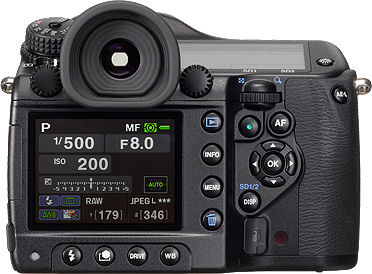 | 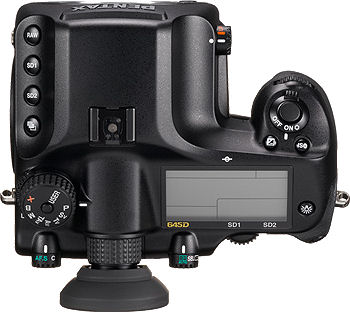 | 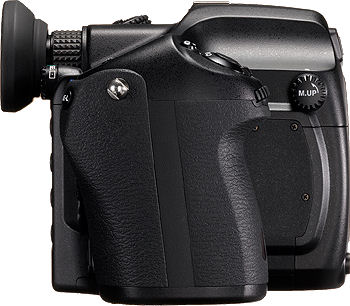 | 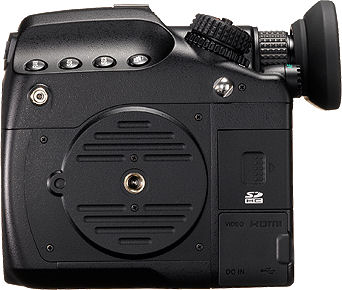 | 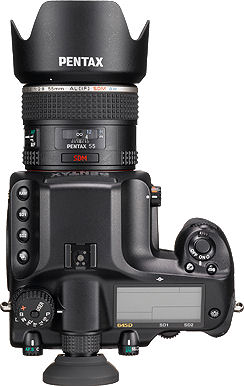 | 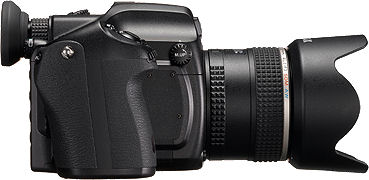 | 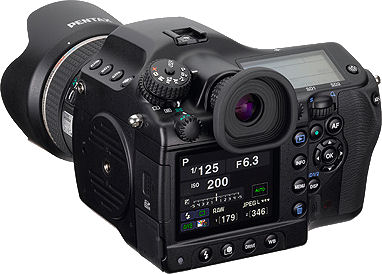 | | |
|
Original Source Press Release:
| PENTAX 645D PENTAX's First Medium-Format Digital SLR Camera:
Designed to be the Top of Medium-Format Digital SLR Cameras,
Thanks to Super-High-Resolution Images HOYA CORPORATION PENTAX Imaging Systems Division is pleased to announce the launch of the PENTAX 645D lens-interchangeable, medium-format digital SLR camera. Thanks to the incorporation of a large image sensor, equal in performance to professional-standard digital camera backs, this high-performance model delivers super-high-resolution images with approximately 40 effective megapixels. It also offers outstanding dependability and superb operability and maneuverability to make outdoor shooting effortless and comfortable for demanding photographers. The PENTAX 645D has been developed to provide super-high-resolution images produced by large image sensors - something previously available only on professional models - to serious landscape and outdoor photographers. It combines exceptional image quality with excellent maneuverability and outstanding reliability to simplify professional-level outdoor shooting. Thanks to the incorporation of a large, high-performance image sensor (measuring 44mm by 33mm) and PENTAX-original image-processing technology, it produces extra-sharp, super-high-resolution images with approximately 40 effective megapixels. It features remarkable durability and dependability, thanks to its lightweight but solidly built body featuring a magnesium-steel-alloy frame, reinforced glass LCD panel protectors and a reliable dustproof, weather-resistant construction. In addition, it is designed to be compatible with the majority of the existing PENTAX 645 system, so that current PENTAX 645-series camera users can take advantage of their valuable assets, including high-performance smc PENTAX 645 interchangeable lenses. Major Features -
Unprecedented image quality -
Super-high-resolution images made possible by approximately 40 effective megapixels
The PENTAX 645D incorporates a high-performance CCD image sensor produced by Kodak. It measures 44mm by 33mm, and is approximately 1.7 times larger than its 35mm-format counterparts. Thanks to approximately 40 effective megapixels, it assures a wide dynamic range to faithfully reproduce the prevailing ambience and the sense of depth in super-high-resolution images that are rich in gradation and truthful in texture description. In order to bring out the full potential of the lens and the image sensor and assure the highest level of image-resolving power, the CCD unit is designed with no low-pass filters. -
High-performance, high-speed PRIME II imaging engine
The PENTAX 645D features the acclaimed, PENTAX-original PRIME (PENTAX Real Image Engine) II as its imaging engine. Thanks to its high-speed data-processing capacity and new algorithm exclusively programmed for medium-format digital SLR cameras, this high-performance imaging engine produces super-high-quality images rich in gradation and faithful in color reproduction, while allowing speedy data transmission of large-volume image data - even RAW-format images as large as some 50MB per file. -
14-bit A/D converter for faithful conversion of image data to digital signals
The PENTAX 645D features a high-performance A/D converter, which faithfully converts the large volume of analog image data output by the large CCD image sensor to digital signals carrying an extensive amount of image data, including resolution and gradation. -
Solid, maneuverable body
The PENTAX 645D's main frame is made of lightweight but strong magnesium-steel alloy, while the chassis is made of diecast aluminum to minimize the expansion and extension caused by heat and also to optimize kinematic accuracy and thermal stability. The LCD panels - one on the camera's top panel, another on the back panel - are covered with tempered glass plates for extra protection. The PENTAX 645D's body is also designed to be a compact and highly maneuverable medium-format camera, despite the incorporation of such dependable features as a dust-proof, weather-resistant construction with 70 special seals, outstanding cold-resistant performance to assure solid operation at a temperature as low as -10°C, and a newly designed shutter unit with a top shutter speed of 1/4000 second that can withstand as many as 50,000 shutter releases. -
Dual SD/SDHC memory card slots
The PENTAX 645D has a pair of memory card slots for the recording of images on both SD and SDHC memory cards. This dual-slot design gives the photographer extra data-storage options: for instance, recorded images can be assigned to different cards according to recording format (such as RAW or JPEG), or one of the cards can be used as the backup of the other. The settings for each memory card slot can be easily made by dedicated button. -
Dependable DR II mechanism to minimize dust spots
The PENTAX 645D comes equipped with the highly dependable DR (Dust Removal) II mechanism, which effectively minimizes annoying dust spots on recorded images, even when the lenses are changed in dust-prone outdoor settings. By shifting UV/IR-cut filters placed in front of the CCD image sensor at supersonic speed using a piezoelectric element, this mechanism effectively and efficiently shakes dust off the image sensor. Thanks to the user-friendly dust-alert system, the photographer can check at a quick glance for dust adhering to the image sensor prior to the actual shooting. -
Newly designed, high-precision 11-point wide-frame AF sensor
The PENTAX 645D's new SAFOX IX + wide-frame autofocus system features 11 sensor points (with nine cross-type sensors positioned in the middle) to assure the extra-high-precision focusing demanded of medium-format digital SLR cameras. To develop this sophisticated AF system, the entire optical system was redesigned, at the same time with the addition of the new functionality to analyze and make use of the light sources data in the field of view. -
Advanced 77-segment multi-pattern metering
The PENTAX 645D employs a state-of-the-art, 77-segment multi-pattern metering system to assure super-high-accuracy light metering. The exposure accuracy is further enhanced by collecting such additional data as image orientation (horizontal or vertical) and the distance to and magnification of the subject using the sensors installed inside the camera body, with the obtained data incorporated into exposure calculations. -
Large, easy-to-see optical viewfinder
Incorporated in the PENTAX 645D's finder unit, a trapezoid-shaped glass prism not only assures an approximately 98% field of view, but also greatly contributes to the downsizing of the camera body. Coupled with a bright, easy-to-focus Natural-Bright-Matte focusing screen, the PENTAX 645D's viewfinder offers a large, clear view of the subject. -
Custom Image function to create desired visual effects with ease
The PENTAX 645D's Custom Image function lets the user easily control an image's finishing touches to more precisely reflect the user's creative intentions, or to more faithfully reproduce the ambience of the scene. The user can select one of eight modes, including the new Reversal Film mode designed to create images with the colors that are typical of reversal film. In addition, all parameters - such as saturation, hue, contrast, sharpness, key, and highlight/shadow contrast - can be easily adjusted to desired levels, so that the photographer can shoot images with great ease. -
Versatile, multi-mode exposure system for faithful reproduction of creative intentions -
Hyper Program function
The PENTAX 645D's Hyper Program function allows the user to instantly switch from Programmed AE mode to Shutter- or Aperture-Priority AE mode with a simple turn of the electric dials positioned around the grip. A single push of the green button shifts the exposure mode back to the original Programmed AE mode. -
Hyper Manual function
When shooting in the Metered Manual mode, the PENTAX 645D's Hyper Manual mode lets the user to instantly set the proper exposure for the subject with a single push of the green button. -
Sensitivity-Priority mode
The unique Sensitivity-Priority (Sv) mode automatically selects the optimum combination of aperture and shutter speed for the user-selected sensitivity. The sensitivity can be shifted swiftly by electronic dial on the back panel. The variable amount of the ISO could be configured to either 1/2 or 1/3 steps per click. -
Shutter/Aperture-Priority mode
Taking full advantage of the unique capability of digital cameras for the automatic shifting of sensitivity at any time, the Shutter/Aperture-Priority (TAv) mode automatically selects the most appropriate sensitivity for the user-selected aperture/shutter-speed combination. It allows the user to effortlessly experiment with a greater range of photographic expressions. -
Large, easy-to-view 3.0-inch LCD monitor with approximately 921,000 dots
Positioned on the camera's back panel, a large 3.0-inch color LCD monitor with approximately 921,000 dots provides a clear, bright view of onscreen images and menus. Since its wide-view design allows quick, effortless confirmation of the monitor image from approximately 170 degrees both horizontally and vertically, the photographer has little difficulty shooting images from low and high angles. The LCD monitor is also treated with exclusive AR (Anti-Reflection) coating to minimize reflections on the screen, even in the outdoor locations under bright sunshine. -
Long battery life
The PENTAX 645D is powered by a large-capacity, rechargeable lithium-ion battery, which can capture approximately 800 images* when fully charged.
* Under testing conditions prescribed by PENTAX, when using a rechargeable D-LI90 lithium-ion battery with no flash. -
Other features -
HDR (high dynamic range) function to create one composite image with an extra-wide gradation range from three images with different exposures -
Dynamic-Range Expansion function to compensate for both whitewashed (excessively overexposed) and blacked-out (excessively underexposed) areas -
Digital Level function for easy checking of the image's levels -
Automatic compensation of distortion and lateral chromatic aberration (available in combination with the D FA 645- and FA 645- series lenses) -
Versatile white-balance control system, including the CTE mode designed to emphasize the dominant color components of the captured images, which works especially well with such scene like sunset. -
Mirror shock/operation-noise reduction function to assure smooth, quiet operation of the mirror during shooting -
Attachment of copyright credits on recorded images -
Compatible with the SDM (Supersonic Direct-drive Motor) autofocus mechanism, designed to assure smooth, quiet operation using the supersonic motor installed inside SDM lenses -
HDMI terminal (for type C mini connectors) for high-resolution image data output -
User-friendly, color-classified control buttons/switches, based on the color universal design concept -
PENTAX Digital Camera Utility 4 software package, including a RAW-data processing application (based on the popular SILKYPIX RAW-data processing engine developed by Ichikawa Soft Laboratory) and browser application * Recording capacity shows approximate number of shots recorded during CIPA-compliant testing. Actual performance may vary depending on operating conditions. -
PENTAX, 645D, and smc PENTAX are trademarks of HOYA CORPORATION. -
PENTAX Digital Camera Utility and SDM are trademarks of HOYA CORPORATION. -
This product supports PRINT Image Matching III. PRINT Image Matching enabled digital still cameras, printers and software help photographers to produce images more faithful to their intentions. Some functions are not available on printers that are not PRINT Image Matching III compliant. -
Copyright 2001 Seiko Epson Corporation. All Rights Reserved. -
Print Image Matching is a trademark of Seiko Epson Corporation. -
The PRINT Image Matching logo is a trademark of Seiko Epson Corporation. -
HDMI, the HDMI Logo and High-Definition Multimedia Interface are trademarks or registered trademarks of HDMI Licensing LLC. -
All other brands or product names are trademarks or registered trademarks of their respective companies. -
Designs and specifications are subjects to change without notice. |
|